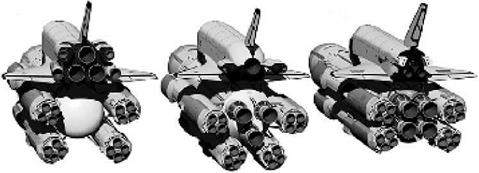Boosters: marrying medium-lift and heavy-lift
By 1976 the design of the RLA-130 had evolved such that it was becoming an ever more daunting task to unify the design of the strap-on boosters and the first stage of
|
Soviet shuttle evolution. From left to right: OS-120, OK-92, and Buran (source: www. buran. ru). |
the 11K77 medium-lift launch vehicle. For one, the strap-ons would now carry the 740-ton thrust RD-170, providing much more muscle than what was needed for the 11K77 first stage and shifting the latter’s impact zone in Kazakhstan [64]. However, the biggest problem was that because of their location in the RLA-130 stack the strap-ons experienced high bending loads, which made it necessary to make the tank walls tougher than was necessary for the 11K77. NPO Energiya proposed to construct the tanks out of a lightweight, but strong 1201 aluminum alloy that was also used for the core stage tanks, but KB Yuzhnoye’s manufacturing facility did not possess the welding technology needed to build such tanks [65].
At one point the differences seemed so irreconcilable that KB Yuzhnoye chief designer Vladimir Utkin was on the verge of ending his co-operation with NPO Energiya. His bureau was simply not up to the task of building two fundamentally different rocket stages. To Glushko the idea of using the 11K77 first stage as a test bed for the strap-ons was so critical that Yuzhnoye’s withdrawal jeopardized the very existence of the RLA-130. There simply was no other organization that could build the strap-ons. Fortunately, Glushko and Utkin were able to hammer out a compromise during an exhausting two-day meeting at KB Yuzhnoye in Dnepropetrovsk [66]. The tank walls would be made of an aluminum-magnesium alloy with a waffle – grid structure and would be somewhat thinner on the 11K77. Other than that, the 11K77 first stage would use virtually the same engines and propellant feed systems. In the end, the commonality between the stages was about 70-75 percent.
On 16 March 1976 the Soviet Communist Party and government issued another decree, which gave KB Yuzhnoye the final go-ahead for the development of the 11K77 rocket. Coming just about a month after the decree on the Soviet shuttle, it seems to have formalized agreements that had been made in the previous months on unifying the 11K77 and RLA-130 designs. That same month Yuzhnoye gave Energomash the required parameters for the first and second-stage engines. The first-stage engine, the RD-171, was almost identical to the RD-170 of the RLA-130 with the exception that it could be gimballed in only one axis rather than two.
The second stage was to be powered by the single-chamber RD-120 LOX/ kerosene engine. Its development was assigned to Energomash rather than KBKhA
|
Energiya strap-on booster (left) and Zenit first stage (source: www. buran. ru). |
in Voronezh, with the latter getting the RD-0120 in return. One of the reasons was that the development of this engine should get underway as soon as possible so that engineers might learn the necessary lessons for the larger RD-170/171. In support of its test program for the heavy-thrust first-stage engine, Energomash had already developed a prototype LOX/kerosene engine that had characteristics very similar to those required for the Zenit second stage. This was based on the RD-268 nitrogen tetroxide/UDMH engine, which was being serially produced for the first stage of Yuzhnoye’s MR-UR-100 ICBM. Finally, the second stage was also to carry a four – chamber RD-8 vernier engine for thrust vector control, developed in-house at KB Yuzhnoye [67].
The preliminary design (“draft plan”) for the 11K77 was finished in February 1977. The March 1976 decree had called for a maiden flight in the second quarter of 1979, but numerous problems (mainly with the first-stage engine) would eventually delay that until April 1985 (see Chapter 6).












